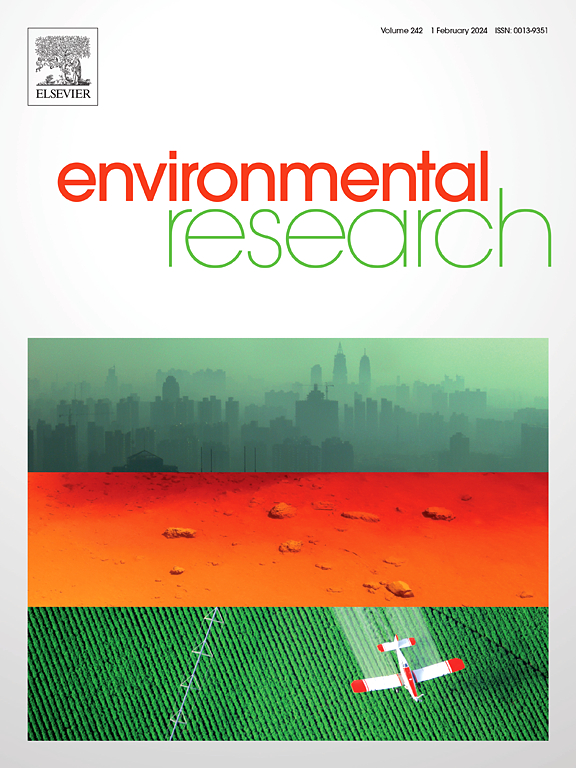Nanoengineering construction of Fe2O3/g-C3N4 heterojunctions for cooperative enhanced photocatalytic CO2 reduction and pollutant degradation
IF 7.7
2区 环境科学与生态学
Q1 ENVIRONMENTAL SCIENCES
引用次数: 0
Abstract
Developing heterojunction photocatalysts represents a promising strategy to improve photocatalytic efficiency in wastewater treatment and address the greenhouse effect. This investigation involved the creation of a new Fe2O3/g-C3N4 heterojunction photocatalyst (FC-X) through a simple hydrothermal process to overcome these obstacles. The optimized FC-8 composite exhibited a high photocatalytic activity, achieving a 95.5 % degradation of RhB within 180 min and a CH4 production rate of 19.72 μmol g−1·h−1 when exposed to visible light, demonstrating a reaction rate constant of 7.02∗10−3 min−1, which is 1.63 and 1.75 times greater than pure Fe2O3 and g-C3N4, respectively. Additionally, FC-8 exhibited an enhanced CO2 reduction rate, producing CH4 at 19.72 μmol g−1·h−1, surpassing Fe2O3 and g-C3N4 by 1.91 and 8.12 times, respectively. Structural, optical, and electrochemical characterizations confirmed that the enhanced performance originates from efficient charge separation and a lower carrier recombination rate at the heterojunction interface. Active species trapping experiments showed singlet oxygen (1O2), superoxide radicals (O2•-) and hydroxyl radicals (•OH) drive RhB degradation, with 1O2 being the dominant contributor. The FC-8 photocatalyst also exhibited excellent stability, retaining over 90 % efficiency after four cycles. This study introduces an encouraging approach to developing heterojunction photocatalysts aimed at sustainable wastewater treatment and CO2 transformation.

Fe2O3/g-C3N4异质结协同增强光催化CO2还原和污染物降解的纳米工程构建
开发异质结光催化剂是提高光催化废水处理效率和解决温室效应的一个很有前途的策略。为了克服这些障碍,本研究通过简单的水热工艺制备了一种新的Fe2O3/g-C3N4异质结光催化剂(FC-X)。优化后的FC-8复合材料具有较高的光催化活性,在180 min内对RhB的降解率为95.5%,CH4的产率为19.72 μmol g−1·h−1,反应速率常数为7.02∗10−3 min−1,分别是纯Fe2O3和g- c3n4的1.63和1.75倍。FC-8的CO2还原速率为19.72 μmol g−1·h−1,分别是Fe2O3和g- c3n4的1.91倍和8.12倍。结构、光学和电化学表征证实,这种增强的性能源于有效的电荷分离和异质结界面上较低的载流子复合率。活性物种捕获实验表明,单线态氧(1O2)、超氧自由基(O2•-)和羟基自由基(•OH)驱动RhB降解,其中1O2是主要的促进因子。FC-8光催化剂也表现出优异的稳定性,在四个循环后保持90%以上的效率。本研究介绍了一种令人鼓舞的发展多相结光催化剂的方法,旨在可持续的废水处理和二氧化碳转化。
本文章由计算机程序翻译,如有差异,请以英文原文为准。
求助全文
约1分钟内获得全文
求助全文
来源期刊

Environmental Research
环境科学-公共卫生、环境卫生与职业卫生
CiteScore
12.60
自引率
8.40%
发文量
2480
审稿时长
4.7 months
期刊介绍:
The Environmental Research journal presents a broad range of interdisciplinary research, focused on addressing worldwide environmental concerns and featuring innovative findings. Our publication strives to explore relevant anthropogenic issues across various environmental sectors, showcasing practical applications in real-life settings.
 求助内容:
求助内容: 应助结果提醒方式:
应助结果提醒方式:


